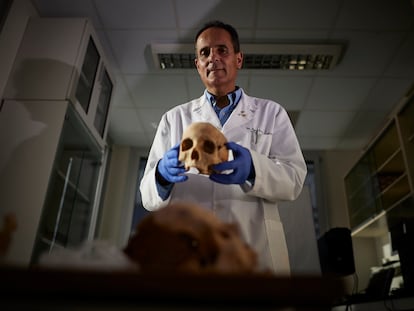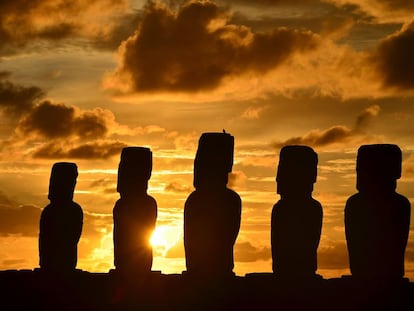Research confirms authenticity of Christopher Columbus’ remains in Spain
A new study of bones that were transferred to the Spanish city of Seville from Havana in 1899 confirms with ‘absolute reliability’ that they belong to the explorer


Researchers have confirmed that that remains housed in a tomb at Seville Cathedral belong to Christopher Columbus with “absolute reliability,” according to forensic scientist José Antonio Lorente, a professor of Legal Medicine at the University of Granada in Spain. This conclusion comes after more than 20 years of research and the application of cutting-edge DNA analysis techniques. A preliminary genetic study conducted in 2003 indicated a “high probability” that the remains belonged to Columbus; however, the technology available at that time meant there was a still a margin of error.
Columbus’ bones have been preserved in a tomb in Seville Cathedral since 1899, when control of Cuba passed from Spain to the United States, and Spanish authorities left Havana, where the explorer’s remains had been interred until then. A series of haphazard transfers over the centuries — first to the Spanish cities of Valladolid and later to Seville, then to Santo Domingo and Cuba — raised questions about whether the bones might have been lost or replaced during these transitions. In fact, Dominican Republic authorities maintain that Columbus’ body never left the island and is still buried in Santo Domingo’s cathedral.
In 2003, historian Marcial Castro and José Antonio Lorente were granted permission to open the tomb in Seville. Inside a casket, they discovered small fragments of bone mixed with soil. The DNA from these fragments was compared to the DNA of Columbus’ son Hernando, who is also buried in the cathedral, as well as with that of his brother Diego. The results were positive, but not conclusive. The destruction of 0.1 grams of bone for each analysis forced the investigation to stop. Researchers decided to wait for advancements in DNA analysis technology before continuing with the genetic comparisons.

That moment arrived in 2020 when the Spanish broadcaster RTVE initiated an investigation into the explorer, the results of which will be unveiled on October 12 in a documentary. Until now, the most widely accepted hypothesis has been that Columbus was of Genoese origin. The University of Granada conducted this study, led by José Antonio Lorente, one of the world’s foremost forensic scientists and a collaborator with various international police forces, including the FBI.
To carry out the investigation, numerous remains of individuals potentially related to the discoverer were analyzed. More than 25 nations and regions in Europe claim to be Columbus’ birthplace, including Italy, Sweden, Norway, Portugal, France, England, Scotland, Hungary, Ireland, Croatia, the Spanish areas of Galicia, Catalonia, Valencia, Navarre, and Mallorca. There is also speculation that he could have been a Sephardic Jew or Agote, a minority group that has faced persecution since the Middle Ages in France and settled in Navarre.
DNA tests were conducted in laboratories across Spain, the United States, Mexico, and Italy. To validate each test, all experts had to arrive at the same conclusions. “The process was carried out independently, with no communication between the clinics, ensuring the objectivity of the data,” said Lorente, who acknowledged that this work represented the most significant undertaking of his career.
The results of the investigation will be published at the end of the month in a prestigious international scientific journal.
Sign up for our weekly newsletter to get more English-language news coverage from EL PAÍS USA Edition
Tu suscripción se está usando en otro dispositivo
¿Quieres añadir otro usuario a tu suscripción?
Si continúas leyendo en este dispositivo, no se podrá leer en el otro.
FlechaTu suscripción se está usando en otro dispositivo y solo puedes acceder a EL PAÍS desde un dispositivo a la vez.
Si quieres compartir tu cuenta, cambia tu suscripción a la modalidad Premium, así podrás añadir otro usuario. Cada uno accederá con su propia cuenta de email, lo que os permitirá personalizar vuestra experiencia en EL PAÍS.
¿Tienes una suscripción de empresa? Accede aquí para contratar más cuentas.
En el caso de no saber quién está usando tu cuenta, te recomendamos cambiar tu contraseña aquí.
Si decides continuar compartiendo tu cuenta, este mensaje se mostrará en tu dispositivo y en el de la otra persona que está usando tu cuenta de forma indefinida, afectando a tu experiencia de lectura. Puedes consultar aquí los términos y condiciones de la suscripción digital.
More information
Archived In
Últimas noticias
Most viewed
- David King, chemist: ‘There are scientists studying how to cool the planet; nobody should stop these experiments from happening’
- Reinhard Genzel, Nobel laureate in physics: ‘One-minute videos will never give you the truth’
- Mexico completes its trade shift with the entry into force of tariffs on China and countries without trade agreements
- Oona Chaplin: ‘I told James Cameron that I was living in a treehouse and starting a permaculture project with a friend’
- Sinaloa Cartel war is taking its toll on Los Chapitos










































